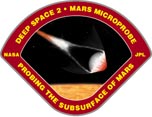 | ||||||||
|

In December 1999, two basketball-sized aeroshells will crash onto the Martian surface at a velocity of about 200 meters per second. Shattering on impact, each aeroshell will release a miniature two-piece science probe that will punch into the soil to a depth of up to 2 meters. The microprobes' primary science goal is to determine if water ice is present in the Martian subsurface - an important clue in the puzzle of whether life exists, or ever existed, on Mars. The tiny science stations will also measure soil temperature and monitor local Martian weather. The microprobes will operate for just about 50 hours, but their designers are looking much further ahead - years into the next century.
The Mars Microprobe Mission, also known as Deep Space 2 (DS2), is the second deep-space technology-validation mission in NASA's New Millennium Program. The mission will test key technologies for 21st-century network missions, in which multiple landers released from a single spacecraft will carry out comprehensive observations of dynamic, complex phenomena such as climate systems and seismic activity. The New Millennium microprobe technologies will enable a wide range of scientific studies that would not be affordable using conventional technologies.
The microprobes, in their protective aeroshells, piggyback aboard the Mars Polar Lander, which launches on a McDonnell Douglas Med-Lite (Delta II) rocket in January 1999. On arrival at Mars 11 months later, in December 1999, the Mars Surveyor Lander detaches from the spacecraft and heads toward a soft landing on the surface to complete its mission.
The landing site for the DS2 microprobes is at the northernmost boundary of the area near the southern polar ice cap called the Polar Layered Terrain, about 200 kilometers from the landing site of the Mars Polar Lander. The terrain's layers of dust and ice may contain a record of climate history, and may be a reservoir for water ice on Mars.

For more information on the Deep Space 2 microprobes, please visit the Deep Space 2 Microprobe website:
| Home | Mars Climate Orbiter | Mars Polar Lander | Deep Space 2 Microprobes |
| Welcome | Mailing List | Links | Credits |
For questions or comments on this website please refer to our list of contacts.